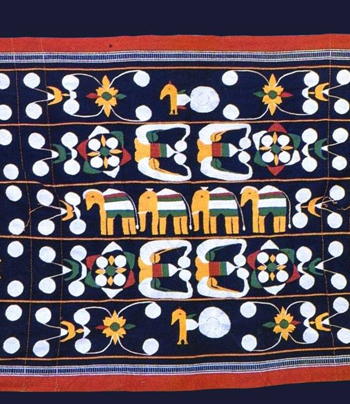Shaphee Lanphee
Shaphee is the fabric of animal and Lanphee is the fabric of war. It is a hand woven fabric and having 10 different highly stylized motifs, such as, i) Iroichi (local name of buffalo horn), ii) Nga (local name of fish), iii) Numit (local name of sun), iv) Phantup (local name of seat), v) Shagol (local name of horse),vi) Shamu (local name of elephant), vii) Ta(local name of spear), viii) Tha (local name of moon), ix) Thawanmichak (local name of star) and x) Wahong (local name of peacock) is the Shaphee Lanphee, The fabric is first embroidered with 40 Nos. of Thwanmichak (the Star) in two extreme margins of the fabric. Secondly, 20 Nos. of Ta (the Spear) and 10 Nos. of Phantup (the magical seat) in two sides in the second row of the fabric are embroidered and the third row is repeated with another set of 20 Nos. of Thwanmichak (the Star) having 10 Thwanmichak in each side, The fourth row is embroidered with 10 Nos. of Iroichi (the buffalo horn) in two sides having 5 Iroichi in each side, Fifth row is represented by five motifs, namely, two Numit (two Sun), two Tha (two Moon) and one Shagol (one Horse) in the middle in each side. Therefore, there are 4 Numit, 4 Tha and two Shagol together in the fabric, In the middle, there are two Wahong (two Peacocks) in the outer margin and two Nga (two Fishes) and two Shamu (two elephants) in the inner centre. The philosophical concept of the different motifs which are needed in the Shaphee Lanphee is that the floral design with the red core is significance the Sun. The white patches at the ends are significance of the stars and the other heavenly bodies in the sky. The concept of the moon and the sun are the symbols of mother and father. The significances of this cloth of attractive motifs are the representation of the relationship between the celestial bodies and the Meitei King. The celestial bodies like sun, moon, star, etc. are the symbolization of the supreme power of mother and father. The motifs of Phantup (magical seat) and the elephant symbolize the royalty. The motifs of spear heads and the fishes are connected with the myth of king Naothingkhong.
Wangkhei Phee
Wangkhei is a name of place within the Imphal East District of Manipur. It is located within Imphal Municipal Area. The Wangkhei Phee famous for its delicate fabric. This type of fabric is known as “Wangkhei Phee” since the fabric was developed first in the Wangkhei area by skilled weavers for Royal family initially. The weavers are still weaving this special type of cloth in a wide scale across the State. It is shown in Manipuri Costume through Ages (India, Bangladesh and Myanmar) published in 2011, p-123 by Mutua Bahadur.
The fabric is woven and widely used across Manipur. The fine cotton Wangkhei Phee was used by the Royal family in the beginning woven by the weavers of Wangkhei Colony near the palace. The fabric is very delicate one in fine cotton yarn. The interlacement of two threads, i.e. weft and warp in the series are woven far apart from each other, and as such, the cloth is fully transparent. It is a fine variety and close-knitted texture of the weft and the warp woven by female weavers. Patches of a uniform design are woven on the cloth at wide intervals throughout the body of the cloth. Originally, this piece of muslin cloth was uniformly made in white. This muslin cloth survives noticeably in developed form. Till date, in a variety of designs both on the body of the cloth and at the borders in various colours, are used.
Moirang Phee
Moirang is a name of historical place under Bishnupur District of Manipur State and the land of legendary hero Khamba” in in the epic of Moirang Kangleirol. It is situated at a distance of 46 Kms away from Imphal, the capital of Manipur. It is also the place where the first INA flag was hoisted on Indian soil in 1944. The Moirang Phee is a name of fabric originated from the Moirang. The Moirang Pheejin design is woven along the border of the fabric and becomes the famous Moirang Phee.
Any colour of fabric of chaddar or half saree or stole woven with Moirang Pheejin will become the Moirang Phee, The “Moirang Phee is a cloth with the Moirang Pheejin design of weft threads interlocked with weft threads of main body during the weaving process. The Moirang Pheejin design is elongated from selvedge towards the middle of the fabric and arranged continuously along the border of the fabric. The Moirang Pheejin design is the shape of pronged teeth of the “Pakhangba”, the Pythonic God of the Manipur mythology. The uniqueness of a Moirang Phee is caused by the presence of the Moirang Pheejin design woven in the fabric along longitudinal border continuous series of geometrical figure of Yarong (pronged teeth). The Moirang Phee fabric is also used The “Moirang Phee is a cloth with the Moirang Pheejin design of weft threads interlocked with weft threads of main body during the weaving process. The Moirang Pheejin design is elongated from selvedge towards the middle of the fabric and arranged continuously along the border of the fabric.
Source: Intellectual Property India






